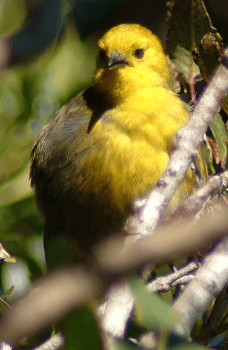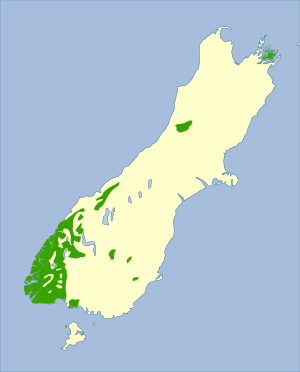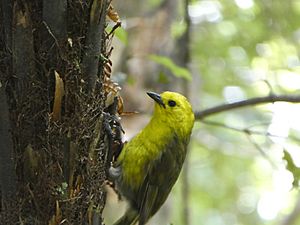Yellowhead (bird) facts for kids
Quick facts for kids Yellowhead |
|
|---|---|
 |
|
| Yellowhead or mōhua | |
| Conservation status | |
| Scientific classification | |
| Genus: |
Mohoua
|
| Species: |
ochrocephala
|
 |
|
The yellowhead or mōhua (Mohoua ochrocephala) is a small bird that eats insects. It lives only on the South Island of New Zealand. This bird was once very common in the forests. However, its numbers dropped a lot after rats and stoats were brought to New Zealand. Now, the yellowhead is an endangered species.
Contents
What's in a Name?
In the 1800s, people called the yellowhead the "bush canary." This was because of its pretty, trilling song. Today, many people in New Zealand use its Māori name, mōhua. Māori people also knew it as mōhoua and houa.
Scientists have recently grouped the yellowhead with its close relative, the whitehead. They are both part of the Mohouidae bird family.
Where Do Yellowheads Live?
The yellowhead lives on the South Island, while the whitehead lives only on the North Island and some small islands nearby. This means they live in different places and don't usually meet.
In the 1800s, mōhua were found all over the South Island. They especially liked the southern beech forests. But in the early 1900s, their numbers fell sharply. This happened because of introduced animals like black rats and mustelids (like stoats and weasels). Yellowheads build their nests in tree holes, which makes them easy targets for these predators.
Today, mōhua have disappeared from most of the South Island's forests. They now live in less than 5% of the areas they used to call home. On the main South Island, you can find small groups in the Marlborough Sounds and near Arthur's Pass. About a quarter of all mōhua live in the beech forests of the Catlins. There are only about 5,000 mōhua left in total.
Helping Yellowheads Survive
In New Zealand, the mōhua is a special bird that is protected because it is threatened and lives only there. People are working hard to help these birds survive.
Moving Birds to Safe Homes
One way to help is by moving mōhua to islands where there are no predators. For example, mōhua populations have been started on Breaksea Island in Fiordland and Ulva Island. Some birds have also been raised in special facilities at Orana Park in Christchurch.
In 2003, 39 mōhua were moved from Breaksea Island to Whenua Hōu / Codfish Island, which is also predator-free. More birds were moved there in 2018, bringing the island's population to about 1,000. There are plans to move more mōhua to other islands in Fiordland.
Fighting Pests to Protect Birds
The New Zealand Department of Conservation (DOC) works to control pests. These efforts have helped some mōhua groups on the main island grow stronger. For example, in the Dart valley, a special biodegradable poison called 1080 was used to control rats. More than 80% of the mōhua survived there, compared to only 10% in areas without pest control.
The number of mōhua in the Landsborough valley has grown four times since 1998. This is thanks to a big pest control program, including using 1080 from the air. The population is now strong enough that some birds can be moved to start a new group on Resolution Island. Similar efforts using 1080 in the Catlins and the Hurunui, Hawdon, and Eglinton valleys have also worked well. In 2014, DOC and TBfree New Zealand reported that other birds, like the bellbird and tomtit, also increased in the Catlins because there were fewer predators.
See also
 In Spanish: Mohoua cabecigualda para niños
In Spanish: Mohoua cabecigualda para niños



